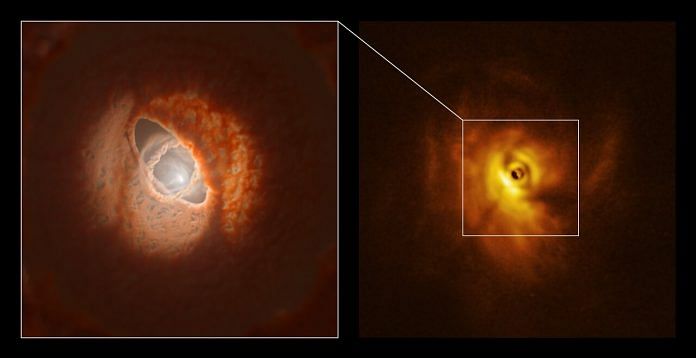Bengaluru: Astronomers have observed, for the first time, a group of stars tearing apart their planet-forming disc. The force of these stars leaves behind material in the form of twisted rings, and the astronomers suggest that this could potentially produce planets with multiple star systems, like the desert-planet Tatooine in the Star Wars movie series, which had two suns.
The study was a collaboration between researchers from the UK, Belgium, Chile, France and the US, who studied the three newborn stars in the GW Orionis system using the AMBER (Astronomical Multi-BEam combineR) and GRAVITY instruments on the European Southern Observatory’s (ESO) Very Large Telescope (VLT) in Chile.
The findings of the study, which was led by Stefan Kraus from the UK’s University of Exeter, were published Friday in the journal Science.
Also read: NASA is tracking a dent that’s slowly widening in Earth’s magnetic field
Star and planet formation
Young stars and star systems form when a cloud of dust and gas collapses under its own gravity, leading to spinning material that eventually forms a disc-like shape. This material surrounding the increasingly gravitationally powerful core, which will eventually become a star, is called the circumstellar disc. This will eventually form planets and other bodies such as asteroids and comets.
When there is only one star in a system, such as our own solar system, the plane of the disc eventually becomes the plane of the star system. But in some star systems, multiple nuclei of stars form, which leads to gravitational confusion and structural disruption of the disc.
Astronomers had never observed such a process occurring before (although we’ve observed plenty of multi-star systems). Theoretical modelling suggests that when multiple gravitationally powerful stars form from the same material, the disc should bend and twist, eventually breaking into concentric, misaligned rings.
The observation of the newly forming GW Orionis system in the constellation of Orion confirms these theories. The star system has three stars and a deformed disc around them, which holds a misaligned ring in the middle, closer to the stars.
“Our images reveal an extreme case where the disc is not flat at all, but is warped and has a misaligned ring that has broken away from the disc,” said Kraus, a professor of astrophysics at the University of Exeter.
The ring was detected by observing its shadow on the rest of the disc. The astronomers state in their paper that multiple rings could potentially form in systems like these elsewhere.
This star system is located 1,300 light years away.
Also read: Astrophysicists spot biggest black hole collision so far, and a mystery begins to unfurl
Planet-forming potential
The research also shows that the inner ring contains material, primarily dust, worth 30 times the mass of Earth. Astronomers think that this gives the system ample opportunity to produce at least one planet.
“Any planets formed within the misaligned ring will orbit the star on highly oblique orbits and we predict that many planets on oblique, wide-separation orbits will be discovered in future planet imaging campaigns,” said the study’s co-author Alexander Kreplin.
This is especially so because the orbits of the three stars, which are going around each other, are also misaligned with respect to each other’s orbital plane and the outer circumstellar disc. The planets are likely to also be in retrograde orbits — that is, revolving in the direction opposite to the star’s rotation.
Scientists have already detected more than 200 stellar systems with multiple stars and planets. About 40 per cent of the exoplanets with less than 40 days orbital periods that have been discovered, are on oblique or retrograde orbits. The most inclined circumbinary planet — a planet that orbits two stars — we know is Kepler-413b.
But scientists have not, until now, observed planets at such an early stage of its formation. The findings, made over 11 years, give us unique insights into planetary formation and evolution. Further observations could strengthen our understanding and aid in the detection of science fiction-like exoplanets.
Also read: India’s AstroSat telescope discovers one of the earliest galaxies to have formed






